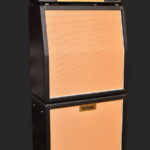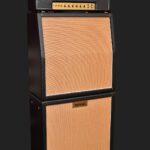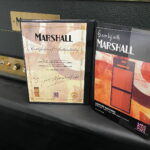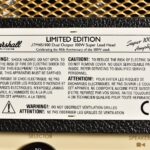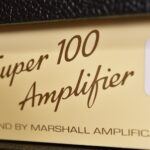#003 OF 250 HANDSIGNED BY JIM MARSHALL
The JTM45/100 Limited Edition run of 250 is an all-valve, 100 Watt head and two 4×12 cabinet setup. It uses two 50 Watt output transformers in its power section, just like the original did in 1965. It was the very first appearance of what has now come to be known as the 100 Watt ‘stack.’
Marshall’s goal for this handwired re-issue is both obvious and simple – to make it as identical to the late 1965 made orginals as possible. To this end the circuit, cosmetics, construction, sound and all-important dynamic characteristics all have to be 100% correct – and they are. Marshall went to incredible lengths to achieve maximum authenticity and are delighted to report that their suppliers were equally as exacting in their tasks.
As you can see from its front panel layout, the JTM45/100 is a traditionally straightforward amplifier. Its two channels – High Treble and Normal – each have two inputs (High and Low sensitivity) and separate Loudness (volume) controls. Both channels share the amplifiers, the JTM45/100 performs at its very best when turned up to deliver your personally preferred dynamic range. Due to its power rating and astonishing projection, it can be a formidable live amplifier in even the largest of venues. A truth bore out by its impressive history time-and-time again.
The JTM45/100’s organic, vibrant, sweetly distorted, harmonically rich and thick musical tone emanates from its power valves being driven into a dual 50 watt output stage. When ‘cranked,’ the JTM45/100 produces its own unique roar with an inspiring ‘punch you in the chest’ clout. It reacts superbly to the guitar’s volume control/player feel combination and, not surprisingly, responds exceedingly well to picking dynamics too. From ‘in-your-face’ when you play with unbridled aggression to subtle ‘in your ear’ blues caresses when you pull back and turn down….just like the celebrated masters of the day.
The speaker cabinets for the Anniversary Stack, 812T40 AND 812B40, have been designed to recreate the majestic look of the original 8x12s when stacked. Marshall could, of course, have replicated the 8×12 but in consideration to your back (and your roadies!) has decided that dividing it into two 4x12s was much more sensible! Just like the original 8×12, both cabs are loaded with Celestion’s highly celebrated T652 Alnico Speakers. The angled top cabinet also features a semi-open back, just like the genuine 8×12 reference we took our dimensions from.
JTM45/100 LIMITED EDITION TECHNICAL INFORMATION:
Components: Wherever and whenever possible, Marshall has gone back to the orginal manufacturers for all components to maintain the highest quality and to ensure maximum authenticity.
Valve compliment: Three ECC83s (12AX7s) in the pre-amp and a quartet of KT66* power valves working in push-pull. All valves are of the highest quality available and are subjected to Marshall’s usual meticulous grading and testing processes.
*KT66: these output valves were standard issue on mid sixties Marshall Amplifiers yielding a fat, round tone that has a distinctly vintage flavour.
The way the three ECC83s in the pre-amp are utilized is as follows-
V1 is the pre-amp gain stage for the High Treble and Normal channels. Each half of the valve (the ECC83 is a dual-triode which means it is literally two triode valves in one) acts as a dedicated gain/input buffer stage for each channel.
V2 is common to both channels which are passively summed at the input of this valve. The first half of V2 acts as a second gain stage, which boosts the signal further and directly drives the second half of the valve which is configured as a cathode follower – a unity voltage gain device which acts as a high input impedance buffer, providing a low output impedance to drive the pre-amp’s passive tone network.
V3 is the amplifier’s phase invertor and sits at the very end of the pre-amp section’s tone circuit. V3 divides its input signal into two separate output signals that are inverted with respect to each other – hence, the name ‘phase invertor’ (a.k.a. ‘phase splitter’). The two resulting signals are then fed to the push-pull power output stage of the amplifier.
Specifications:
Output (RMS) – 100 Watt (2 x 50 Watt)
Channels – 2
4 Band EQ – yes
Pre-Amp Tubes – 3 x ECC83
Power Amp Tubes – 4 x KT66


